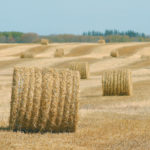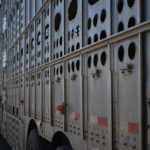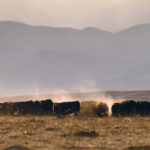Getting a feed test done and knowing what they have on the farm will allow producers to balance their rations
ROCKY MOUNTAIN HOUSE, Alta.— Feed testing is the best way to ensure cows are getting a balanced diet. “Just visually looking at it isn’t going to give you those values of energy and protein. Your eye is not able to determine that,” said animal nutritionist Cornelia O’Keefe of Blue Rock Animal Nutrition in Innisfail, Alta. […] Read moreStories by Barbara Duckworth
Cereal grain breeding faces political and trade challenges
BANFF, Alta. — Plant breeders have the technology to transform wheat into a more productive, disease-resistant crop but politics may get in the way. Farmers could lose access to useful new varieties developed with new genetic technologies because some markets will not accept them, said Stuart Smyth of the University of Saskatchewan. He holds the […] Read more
Rotational grazing helps producers boost pasture health
Producers can use a two-litre pop bottle to gauge when they should graze and when they should move cattle off a field
Rotational grazing is the key to building healthy pastures. Producers may adopt intensive systems, mob grazing, adaptive grazing or cell grazing controlled with permanent and temporary fences, said pasture specialist Jack Kyle. A former pasture specialist with the Ontario ministry of agriculture, he now works with Gallagher Power Fencing Systems. “Rest and recovery is the […] Read more
High-quality feed best saved for post-calving
Producers facing feed shortages can feed straw and chaff to weaned animals, mid pregnancy cows and mature bulls
ROCKY MOUNTAIN HOUSE, Alta. — Straw might not be a cow’s first meal choice, but it might be all that is on offer this winter. Cows need to be well fed to make sure they reproduce next year. “With feed shortages using straw and grain rations, what will happen next year if you don’t have […] Read more
Transport code of practice in works
The code will cover cattle, pigs, poultry, sheep and equine for road transportation and should be completed by 2023
New regulations and a code of practice for livestock transportation are coming. The scope of the code of practice covers cattle, pigs, poultry, sheep and equine for road transportation, said Jackie Wepruk of the National Farm Animal Care Council. “We need to make sure the codes are in line with regulatory expectations. It is very […] Read moreU.S. beef quality audit continues to find bruised cattle
KANSAS CITY, Mo. — Continuing research into bruises on cattle shows the problem is not going away. A 2016 national beef quality audit in the United States found a loss of $124 million because of bruises that had to be trimmed away as waste. A Canadian audit for the same period reported 32.6 percent of […] Read more
Gene editing could form next generation of seed treatments
BANFF, Alta. — Advances in genetic research could reduce the need for powerful fungicides to control common grain diseases. RNA Interference technology has been used to “switch off” genes and help scientists learn more about what is happening at the cellular level of plants. “It is good at shutting down messages so it is a […] Read more
More red meat arriving in Canada from European Union
Beef imports from the United Kingdom to Canada have grown more than 10 percent since a trade deal was ratified in September of 2017. While the Canada-European Union Comprehensive Economic and Trade Agreement granted Canada significant new beef and veal market access to the EU, business has been both ways. For the 12-month period from […] Read more
Feed shortage increases importance of storage and feeding methods
ROCKY MOUNTAIN HOUSE, Alta. — Widespread feed shortages could make it tough for cattle producers to find enough supplies at affordable prices this winter. That makes waste prevention more important than ever. Storage sheds are ideal but many producers leave bales outside and that can affect nutritional value. Round bales left outside lose their shape […] Read more
Canada is third in the world for herbicide-resistant weeds
BANFF, Alta. — Producers across Canada battle at least 77 herbicide-resistant weeds every year. Next to the United States and Australia, Canada has the third-largest population of weeds resistant to one or more herbicides. Most of the problems have appeared in the last 30 years, at a time when few new herbicides have been registered […] Read more





